 Czechoslovakia Catalogs
Czechoslovakia Catalogs

 Czechoslovakia Catalogs
Czechoslovakia Catalogs

| There are several countries and parts of countries in this region of the world that changed hands many times, especially during war years. For that reason, all the Czech and Bohemian countries will be listed under Czechoslovakia. German companies that were always German run and located within Germany itself, are listed under Germany. In 1918, after World War I, Czechoslovakia became an independent country so anything marked "Czechoslovakia" was made after 1918. |
|
Glasraffinerie und Kronleuchterfabrik - Carl Hosch (Glass Refiner and Crystal Chandelier Fabricator - Carl Hosch) was founded in 1864 and was nationalized in 1945 by the Czechoslovakian government.
The firm produced crystal chandeliers for the cathedral in Sydney, Australia, and for the king's palace in Addis Ababa; and lighting for the National Bank of Lisbon, Spain. The firm also exported hollow glass to all parts of the world. In 1929, the firm had 300 employees, many working in the firm's refinery. The Hosch firm also bought finished glassware from the best refineries in Bohemia to sell in its export showroom. The Hosch catalogs were photographed in the Rakow Library, Corning Museum of Glass and in the Glass Museum of Novy Bor, Czech Republic. Thanks to Deborah Truitt, author of several books on Bohemian glass for this information and catalog pictures. |
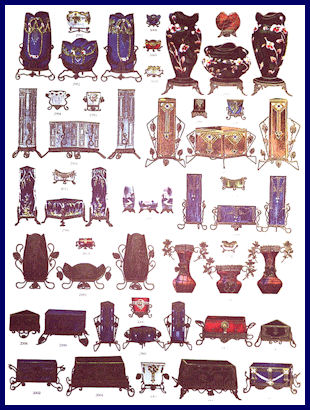 Hosch 1906 |
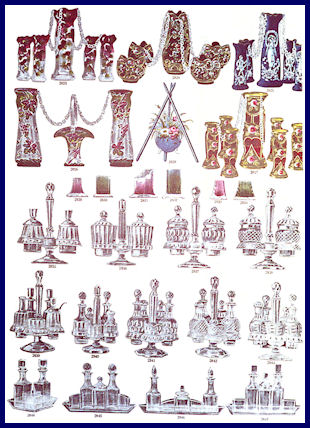 Hosch 1914 |
 Hosch 1912 |
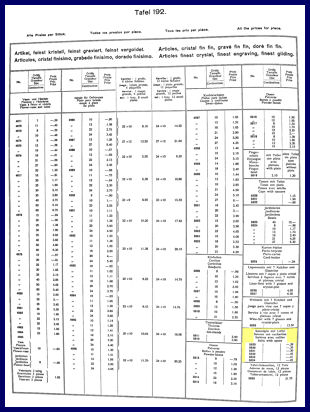 Hosch 1912 Prices |
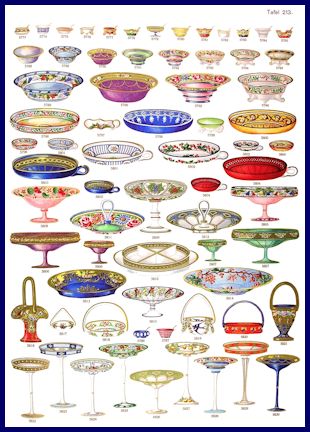 Hosch 1912 |
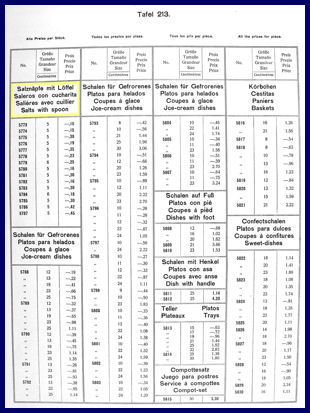 Hosch 1912 Prices |
|
Working in Paris, Heinrich Hoffman designed and made glass molds that were sent to Czechoslovakia (called Bohemia prior to 1918), to the factory where the glass was produced. Hoffman used an open-winged butterfly to identify his work but the mark is not always present on all Hoffman glass.
Heinrich Hoffman's daughter, Charlotte, married Henry Schlevogt in the late 1920s. Henry was the son of Curt Schlevogt who owned another glass factory. Henry Schlevogt worked on perfecting the technique for the semiprecious stone glass. They were able to produce many opaque colors of glass, as well as the variation of colors in lapis lazuli, malachite, turquoise and jade. This German website www.pressglas-korrespondenz is a treasure trove of information on German pressed glass. This link shows some of the following catalog items, especially the Heinrich Hoffman intaglios. Click on ashtrays at the very top to see the intaglios, and also on miscellaneous to see some condiment sets and doubles. |
|
Josef Inwald founded a firm in 1862 that owned glass factories and refineries throughout the Austro-Hungarian Empire.
In the early 1900s, the Inwald factory named Rudolfova Hut (in Dubi near Teplice) was one of the largest producers of pressed glass in Bohemia. This factory was nationalized in 1945 by the Czechoslovakian government. It still produces glass today. The firm used a number of trade names. Barolac and Orlow are two used on pressed glass. It exported glass to all parts of the world. Thanks to Deborah Truitt, author of several books on Bohemian glass for this information and some of the catalog pictures. |
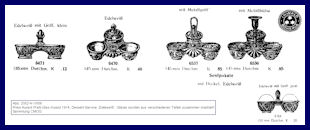 Inwald 1914 |
|
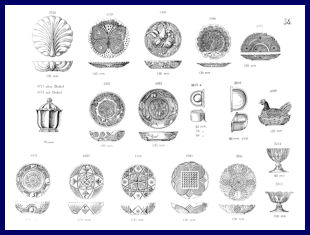 Inwald 1914 |
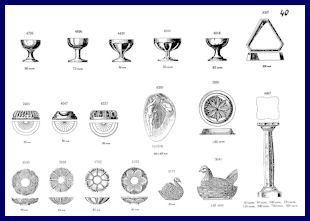 Inwald 1914 |
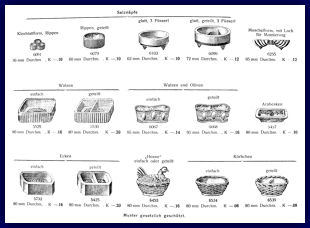 Inwald 1914 |
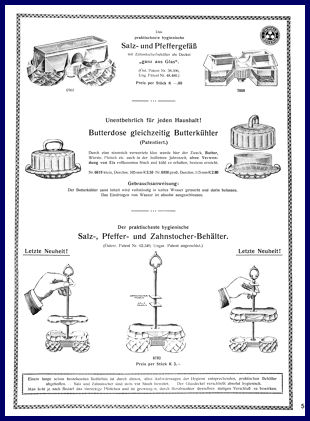 Inwald 1914 |
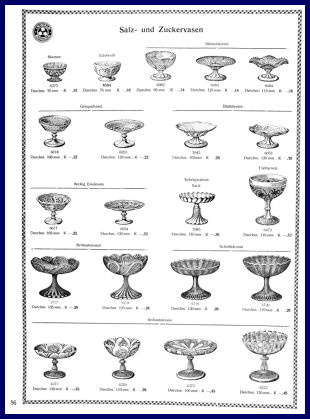 Inwald 1914 |
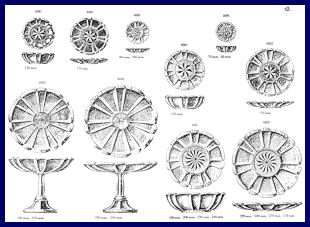 Inwald 1914 |
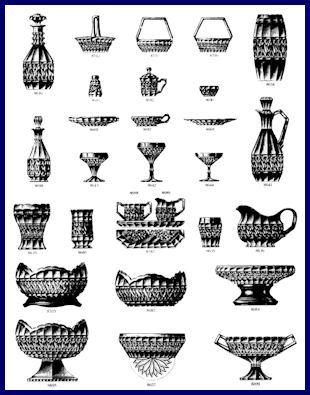 Inwald 1924 |
|
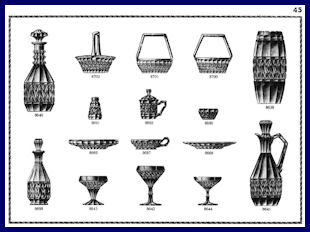 Inwald 1928 |
 Inwald 1928 BLUMENBAND Pattern |
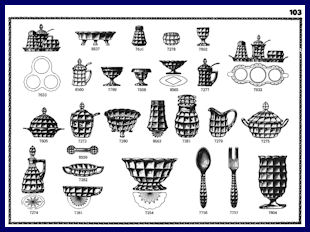 Inwald 1928 MILORD Pattern |
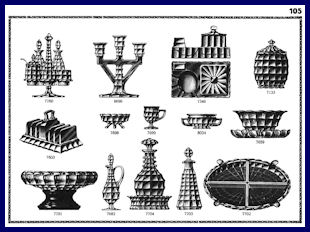 Inwald 1928 MILORD Pattern |
 Inwald 1934 |
|
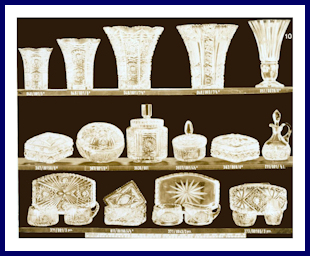 Kamenicky Senov 1950 |
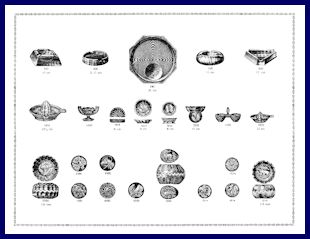 Libochovice 1925-28 |
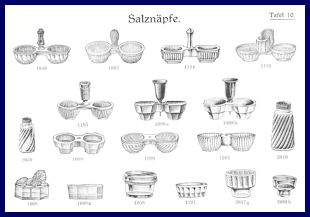 Rindskopf 1915 |
 Rindskopf 1915 |
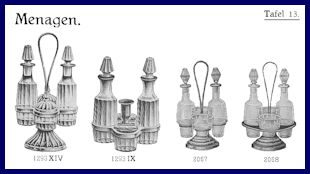 Rindskopf 1915 |
|
|
Josef Franz Romisch (1788-1832) was a glass trader in Steinschonau (Kamenicky Senov) and a talented draftsman. He delivered glass to Russia and to America (by way of Hamburg).
He was born into and married into wealth, but the bankruptcy of the Austrian state in 1811 ruined him financially. In the mid-1820s he started an album of patterns for the glass industry. The material published in 1832 contains thousands of shapes and decorations. It is a wonderful resource for seeing the state of glass art during the Biedermeier Period. Lit. F is the section that depicts salt cellars. These two catalog pages were photographed in 2007 at the Glass Museum in Novy Bor. The two pages differ only in the coloring of the shapes of the salts. Thanks to Deborah Truitt, author of several books on Bohemian glass for this information and catalog pictures. |
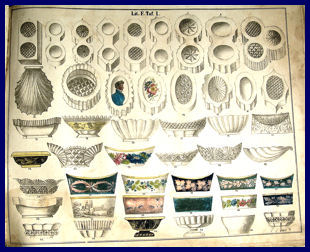 Romisch 1832 |
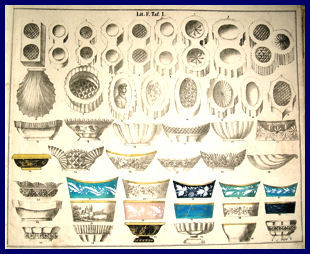 Romisch 1832 |
 Stolzle Royal c. 1930 |
 Stolzle Royal c. 1930 |
| Other Countries: | |||||||
 USA |
 Austria |
 Belgium |
 Bulgaria |
 Denmark |
 England |
 Finland |
 France |
 Germany |
 Ireland |
 Netherlands |
 Norway |
 Poland |
 Spain |
 Sweden |
 Switzerland |
|
|


|

|